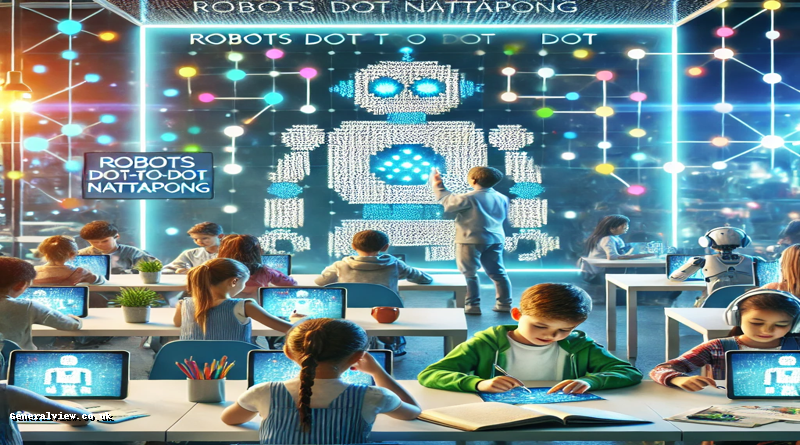
Unlocking Learning with Robots Dot to Dot Nattapong
Introduction
Education as a discipline has experienced a major revolution in the recent past, particularly with the use of information technology. As for the great ideas that have recently been introduced, Robots Dot to Dot Nattapong is a rather curious combination of two well-known activities: the dot-to-dot puzzle and robotics. In this article, the author focuses on Robots Dot to Dot Nattapong to analyze the advantages, uses, and consequences of educational processes.
What is Robots Dot to Dot Nattapong?
Robots Dot to Dot Nattapong is a kind of game that can be used to teach young learners with interest and fun of play. The tool is an interactive dot-to-dot picture that, when solved, shows instructions for a robot to follow. This creates a new approach to filling the gap between discrete learning activities and advanced technological products for learners to explore actual programming and robotic systems.
Benefits of Robots Dot to Dot Nattapong
The integration of Robots Dot to Dot Nattapong in educational settings offers numerous benefits for learners, including:
- Improved problem-solving skills: This way of presenting information makes the learners engage in critical thinking and therefore solve problems as seen in the dot-to-dot puzzle.
- Enhanced programming skills: This way of designing encourages learners to acquire an understanding of the programming concepts as well as the terms used by giving out instructions to the robot.
- Develops STEM skills: STEM is fulfilled in this robot known as Robots Dot; This robot educates the learner on core concepts of science, technology, engineering as well and mathematics.
- Fosters creativity and innovation: The tool fosters creativity and innovative solutions where the learners can work out creative solutions.
Applications of Robots Dot to Dot Nattapong
Robots Dot to Dot Nattapong has a wide range of applications across various educational settings, including:
- Classroom instruction: Teachers can use the tool in class to teach programming concepts, educational computational thinking skills, and strategies.
- After-school programs: Nattapong can use Robots Dot in after-school care to help learners have a positive engagement while teaching them programming and STEM skills.
- Competitions and events: Competitions and events may also use the tool to challenge learners and encourage them to think outside the box in their work.
How to Use Robots Dot to Dot Nattapong
Using Robots Dot is a straightforward process that requires minimal setup and instruction. Here’s a step-by-step guide to get you started:
- Setup the robot: Start by installing the robot as the manufacturer’s guidelines will indicate as follows:
- Create the dot-to-dot puzzle: Sketch a dot-to-dot puzzle by using a software tool to draw one, or hand design a diagram on paper.
- Solve the puzzle: To do this instructing the robot, let the learner trace the dot-to-dot pound to achieve this.
- Execute the instructions:. As it has been said, once the puzzle is solved the robot will follow the instructions given to him.
Comparison with Other Educational Tools
Robots Dot to Dot Nattapong offers several advantages over other educational tools, including:
| Feature | Robots Dot to Dot Nattapong | Other Educational Tools |
|---|---|---|
| Interactivity | Highly interactive, engaging learners in a hands-on experience | Limited interactivity, often relying on passive learning |
| Programming skills | Develops programming skills and concepts | May not provide comprehensive programming instruction |
| STEM integration | Integrates concepts from science, technology, engineering, and mathematics (STEM) | May not provide comprehensive STEM instruction |
FAQs
Some frequently asked questions about Robots Dot to Dot Nattapong are here.
What is the recommended age range for Robots Dot to Dot Nattapong?
The recommended age range for Robots Dot is 8-14 years old.
Can Robots Dot be used in special education settings?
Robots Dot can adapt Yes for use in special education settings to provide learners with a fun and interactive way to develop programming and STEM skills.
How does Robots Dot align with educational standards?
Robots Dot is consistent with the educational curriculum in programming, Science, Technology, Engineering, and Mathematics, and presents learners with a clear understanding of these areas.
Conclusion
Robots Dot to Dot Nattapong is an educational tool that combines Dot-to-dot puzzle game and robotics technology. On the same note, Robots Dot provides an exciting engagement of learners in the programs in that it enables them to practice programming and STEM projects in a controlled environment. As we move to the future with ever-advancing technology. There is a need to have such tools as Robots Dot. That can enable the learners to gain the required knowledge for coping with the future world.
Future Directions
The integration of Robots Dot to Dot Nattapong into educational curricula and beyond holds immense potential. As technology advances and educational methodologies evolve, here are some future directions that this innovative tool could take:
1. Expansion to Different Age Groups
At present, Robots Dot is primarily designed for children in the elementary school age range. With adjustments in complexity and content, educators could adapt this tool for younger children in preschool or even for older students in middle school and high school. This would make it possible to disseminate education across different age and development stages of the juvenile’s life.
2. Incorporation of Artificial Intelligence (AI)
Integrating AI into Robots Dot could significantly enhance its educational value. AI could use to monitor a child’s thinking patterns, solve problems, and provide feedback as the thinking process progresses. The remarks indicated above could assist children to know their weak areas and design their learning process effectively.
3. Virtual and Augmented Reality Integration
The application of the Faculty of Virtual Reality (VR) and augmented reality (AR) into Robots Dot could change the learning experience. A child can put on the VR headset and enter a whole new world where they solve dot-to-dot puzzles. That controls robotic structures. AR can enable robots to come into the real world in a way that can enable children to see the real impact of the puzzles.
4. Collaborative Learning Platforms
Developing Robots Dot into a collaborative learning platform could foster teamwork and communication skills among children. This platform could allow multiple children to work together on a puzzle, with each child contributing to the solution. The robots could then execute the collective solution, teaching children the value of collaboration and cooperation.
5. Accessibility Features
To make Robots Dot more inclusive, developers could focus on incorporating accessibility features. This could range from text-to-voice for visually impaired students, customizable font size and color for dyslexic students, and incorporation of assistive tools like the screen reader.



Average Rating